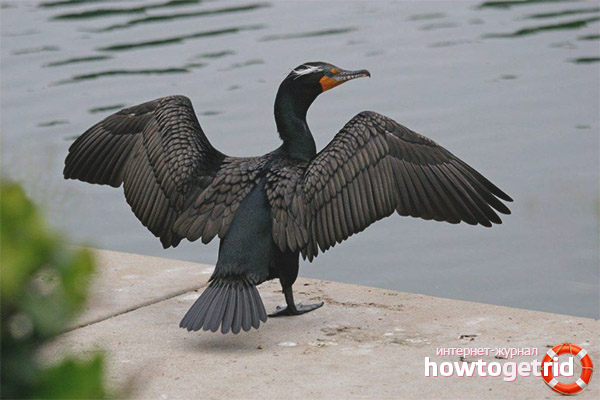The content of the article
The crested cormorant is a seabird that belongs to the Pelican-like order, the Cormorant family. All birds of this order have one similar feature - they can swim and feed mainly on fish. All Pelicans have small nostrils that prevent water from entering the airways, membranes on their feet, which allow them to swim in the water, and waterproof feathers. However, the crested cormorant has its own distinctive features.
View description
The second name of the species is the long-nosed cormorant. It is connected with the fact that the beak of this species of cormorants is somewhat longer than that of all the others. Each of the representatives of the family has its own habitat and features of appearance. A distinctive feature of the crested cormorant is the crest on the head and the relatively large length of the beak.
The size of birds of this species is on average about 70 cm, the weight reaches 2 kg, the wingspan is about 1 m. The length of the crested cormorant's beak is about 7 cm, which can be compared only with the large cormorant, but it is almost twice as large as the crested cormorant, because the relative length of the beak more among crested members of the family, whence came their second name.
Cormorants are covered with black feathers with a metallic greenish tint. A distinctive feature of the described species is that they do not have specks of a different color. Only in young representatives of the species, sometimes a bright, not very bright spot can be found on the cheek or neck. Other members of the family are characterized by white or red spots on the face or neck.
All members of the family feathers are not completely waterproof. After swimming, the cormorant is forced to stay in the sun for a long time and dry its plumage.
Prevalence
Cormorants are thermophilic birds. Southern representatives of the species lead a sedentary lifestyle, since the ambient temperature allows them to feel comfortable all year round. The northern representatives are forced to make flights to warmer countries when the cold season comes.
In Russia, the crested cormorant can be found on the Kola and Crimean peninsulas. Moreover, its prevalence is sporadic. In some regions of Crimea, there are more representatives of this species than other seabirds, while in others they are almost never found.
Interesting Facts
There are several interesting facts that relate to this type of bird:
- Unexpressed sexual dimorphism. In crested cormorants, males and females differ only in size. Males are somewhat larger, but only an experienced ornithologist can notice this difference. In general, males and females have the same color and are very similar. Representatives of both sexes hatch eggs in turn, because it is very difficult to understand which of them is who.
- A bird that does not like to fly. Crested cormorants is one of those rare animals that, having wings and legs, still prefers to swim. Cormorants can fly, but their flight is very difficult, they are often forced to flap their wings. Cormorant flies if you need to go down from a cliff or move to a new habitat. Cormorant also does not like to walk, his gait is unstable.
- Floats like a submarine. Unlike most birds that seem to sit on the water, the cormorant plunges into it along the very neck.Also, these birds dive well and can move under water.
- Protected view. The crested cormorant is a species listed in the Red Book of Russia, Ukraine and the Black Sea. However, in general in the world this species is considered safe and quite common. In the global view, the crested cormorant is a species with minimal risks of extinction.
- A bird who loves to change clothes. Crested cormorant can be called a real mod. The fact is that his chicks hatch not black, but dirty brown. As they grow older, the birds gradually darken. So, in nesting adolescents, the back and back of the head and neck are black, and the stomach and front of the neck are off-white. In the first breeding season, the bird’s back acquires a greenish metallic tint, and the stomach turns black, white spots remain only on the neck or cheeks, but they are not distinct. Adult individuals are completely covered with black feathers with a green tint, and in the mating season a crest appears on their heads. The rest of the time, the crest is absent.
It can be concluded that the crested cormorant is a protected species listed in the Red Book. This is a seabird that swims better than it walks or flies, dives well and feels comfortable under water. Males and females of this species almost do not differ from each other and in size resemble the average duck. You can meet a cormorant in Russia on the Kola and Crimean peninsulas, but it is difficult to recognize it, since it has a characteristic appearance only in adulthood and in the mating season.











Submit